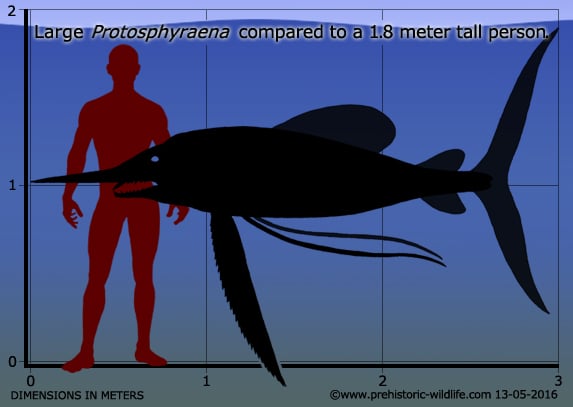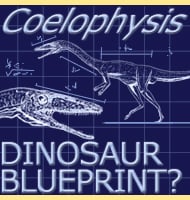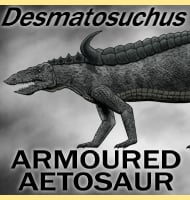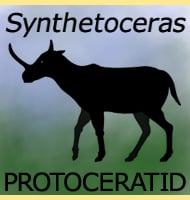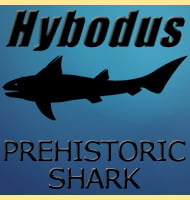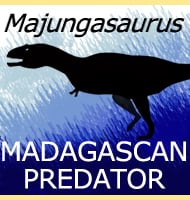In Depth
Protosphyraena means ‘early Sphyraena’, a reference to the Sphyraena genus which includes the modern day barracuda. This all came down to the original interpretation of the first fossils which were very much like those of barracuda. However, later fossil examples of Protosphyraena revealed it to be more swordfish-like in appearance, though it must be noted that today Protosphyraena is not considered to be a relative of either barracuda or swordfish.
Protosphyraena is a predatory fish that was built for high speed, either steady cruising or sudden bursts after prey. The body is long and streamlined with high forks to the tail that provide an efficient large area to push against the water. The pectoral fins are also very long as well which is also an indicator of high swimming speeds as they act as hydroplanes to keep the body level when swimming forward. The faster the movement forward, the larger the pectoral fins need to be to counter this effect.
Aside from acting as hydroplanes, the pectoral fins of Protosphyraena may have also been killing weapons in their own right. The fins of Protosphyraena perniciosa particularly were reinforced with a hard keratinous substance, could grow to over a meter in length and also had a serrated edge on the anterior (frontal) plane. They would for a lack of a better term been almost like a pair of swords.
Protosphyraena also had a long yet robustly formed snout and under this a mouth which housed large, forward pointing teeth. One popular view of Protosphyraena hunting is that it rammed into the flanks of large aquatic creatures (much like as has been speculated for the ancient shark Edestus) like mosasaurs, as postulated in the Hunting Dinosaurs on the Red Deer River, Alberta, Canada by Charles Sternberg. In this example Protosphyraena would spear the animal with its snout, burying its head up to its eyeballs while lashing at the sides with its sword-like pectoral fins.
As dramatic as that sounds, it perhaps is not very likely, after all mosasaurs themselves were predators, and while smaller ones like Platecarpus, may have been threatened by such fish, especially if hunting in shoals, larger ones like Tylosaurus would be more inclined to take the opportunity of a quick snack. Modern sword fish use their long snouts to lash out at fish, stunning and wounding them so that they cannot swim away, and while the snout of Protosphyraena was not as long as modern swordfish, it could still have been combined with the pectoral fins to lash out at several fish in a ‘bait ball’ so that a few injured ones could then be picked off.
It should also be noted however that the pectoral fins between different species of Protosphyraena differed in length and form, with those of P. nitida being notably shorter than those of P. perniciosa. The pectoral fins of P. perniciosa may have also served a defensive purpose, making it very difficult for an apex predator such as a large mosasaur to swallow a Protosphyraena without the fins getting stuck in the throat.
Further Reading
- On an extinct genus of saurodont fishes. - Proceedings of the Academy of Natural Sciences of Philadelphia 24: 280–281. - Edward Drinker Cope - 1873. - On two new species of Saurodontidae. - Proceedings of the Academy of Natural Sciences of Philadelphia 25:337-339. - Edward Drinker Cope - 1873. - Remarks on Saurocephalus and its allies. - Transactions of the American Philosophical Society 11: 91–95. - J. Leidy - 1857. - A contribution to the knowledge of the ichthyic fauna of the Kansas Cretaceous. - Kansas University Quarterly 7(1):22-29, pl. I, II. - A. Stewart - 1898. - Notice of three new Cretaceous fishes, with remarks on the Saurodontidae Cope. - Kansas Univ. Quar. 8(3):107-112. - A. Stewart - 1899. - Biostratigraphic distribution of species of Protosphyraena (Osteichthyes: Actinopterygii) in the Niobrara and Pierre Formations of Kansas. - Proceedings of the Nebraska Academy of Sciences and Affiliated Societies, 89th Annual Meeting, p. 51-52. - J. D. Stewart - 1979. - The stratigraphic distribution of late Cretaceous Protosphyraena in Kansas and Alabama, Geology, by J. D. Wilson. In, aleontology and biostratigraphy of western Kansas: Articles in honor of Myrl V. Walker, Fort Hays Studies, 3(10):80-94. - M. E. Nelson (ed).
